Amazon Brand Tailored Promotions Guide 2025 ( Personalized Deals That Drive Loyalty)
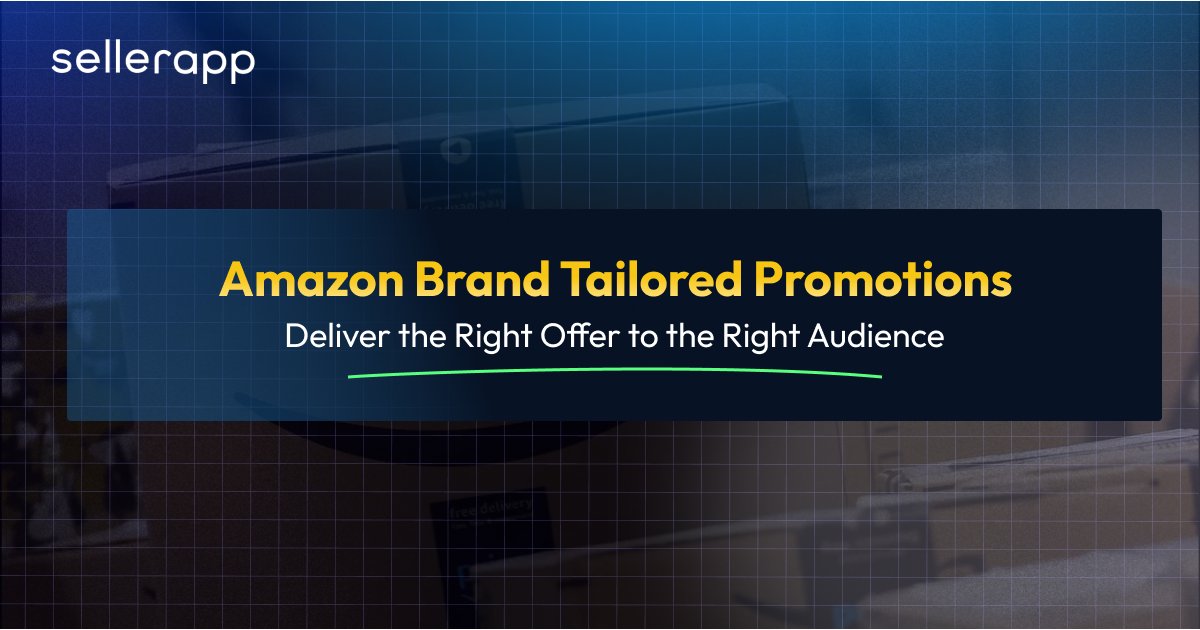
Amazon Brand Tailored Promotions help sellers move beyond generic discounts into real customer connections by delivering specifically what they need. In today’s crowded marketplace, generic discounts are not sufficient. Instead of shouting into the void with blanket offers, brand-tailored promotions Amazon lets you deliver tailored incentives, drastically improving the chances of conversion.
When paired with SellerApp’s data-driven insights on audience segmentation, sellers can fine-tune audiences, optimize discounts, and time promotions with seasonality in mind.
Let’s dive deep into how to run promotions that don’t just ‘run’ but bring in desired results. Then keep reading.
In this guide, we’ll cover how to set up an Amazon Brand Tailored Promotions, editing and deactivating promotions, budgeting strategies to avoid early expiration, audience types that you can align with your targeting goal, the current shape of the feature, and everything a seller needs to know before they create Amazon Brand Tailored Promotions.
What Are Amazon Brand Tailored Promotions?
Amazon Brand Tailored Promotions (BTPs) are a powerful marketing feature introduced in 2023, which goes far beyond Amazon’s traditional, broad-based promotions like Prime-only deals.
It allows you to curate personalized discount offers (up to 50% off) to customers, which makes it more appealing for individual cases, leading to more conversions. These discounts are planned based on purchase behavior, spending history, and engagement with the brand.
For example, you can see a flat 5$ discount coupon on the product page of your regular instant coffee brand, which someone else scrolling through won’t receive. It’s an exclusive discount for you because you’re coming back to the same product.
What makes Amazon Brand Tailored Promotions is that they offer better discount segmentation, be it at the ASIN level, including new groups like views remarketing, cart remarketing, one-time customers, lapsed customers, in-market customers, and complementary products remarketing.
You can also align promotions with your business objective, choosing goals like New Customer Acquisition, Customer Retention, Re-engagement, or Cross-Sell, which helps tailor promotional strategies to your broader marketing goals.
From the UI perspective, these discounts show up in high‑visibility spots, like your product detail page, search results, Brand Storefront, or Amazon’s dedicated promotion page.
How SellerApp used Amazon Brand Tailored Promotions to Lift Reelskin’s New Customer conversion rate
Cart abandonment is one of the biggest pain points for ecommerce sellers, especially in high-ticket categories where hesitation is natural. Shoppers explore, compare, and then drop off, often searching for cheaper alternatives. Every abandoned cart increases the risk of shoppers buying from competitors instead.
For Reelskin, a premium UK-based tattoo skin brand, was facing a recurring challenge on top of the high ticket hesitation. Reelskin saw significant sales from branded keywords but atreacting new customers was becoming challenging.
Running ads to bring in interested customers was costly, but without conversion, the ROI stalled. To turn this challenge into an opportunity, SellerApp rolled out Brand Tailored Promotions (Amazon) aimed specifically at high-intent shoppers who had shown interest but never crossed the finish line.
By offering a 10% discount exclusively to new customers, Reelskin was able to:
- Recover lost traffic with an incentive that felt personal, not pushy.
- Nudge first-time buyers into completing their purchase, without resorting to blanket discounts across the catalog, which could potentially affect generating profits..
Thus, a noticeable increase in Reelskin’s new customer conversion rate was noticed, proving that even a modest targeted discount can bring in customers when applied to the right audience.
Eligibility and Access to Brand Tailored Promotions
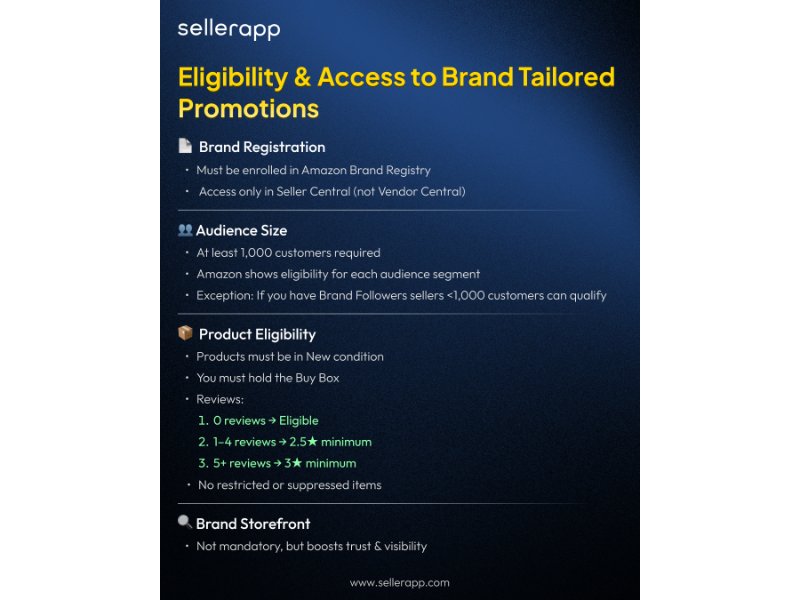
Here’s what you need to know before you create Amazon Brand Tailored Promotions:
1. Brand Registration & Access
First things first, only brand-registered sellers can run brand-tailored promotions on Amazon. If you’re enrolled in the Amazon Brand Registry, you’ll find this feature right inside Seller Central under the “Advertising” tab. (Here’s a heads up, this isn’t available for Vendor Central.)
Note: If your account was invited, make sure you or your team has global or admin-level permissions; otherwise, you won’t see the Brand Tailored Promotions (Amazon) dashboard at all.
2. Audience Size Requirements
To launch a brand tailored promotion on Amazon, you need an audience pool of at least 1,000 customers. This ensures your campaigns have enough reach to make an impact.
But how do you understand if your audience pool is above 1000?
When you select a specific audience type e.g., “Brand Followers,” “Repeat Customers,” “High-Spend Customers” to run a certain campaign, Amazon will show you whether that segment is eligible. If the group doesn’t meet the 1,000-customer minimum threshold, the option will be grayed out or blocked.
There’s one possible exception in this case. Brand Followers. If you’ve built a following through your Amazon Brand Storefront (people who clicked “Follow” on your brand), Amazon sometimes allows you to run promotions to that group even if it’s under 1,000 followers.
Remember, Amazon may block it if the pool is too small. That’s why you’ll always want to check your amazon Seller Central dashboard before setting it up.
3. Product Eligibility
Not every product makes the cut. Amazon sets some guardrails to ensure promotions showcase quality and credibility. Here are the conditions:
- Products must be in “New” condition
- You must hold the Buy Box (Featured Offer)
- Review thresholds matter. 0 reviews? You’re in. 1–4 reviews? You’ll need an average rating of at least 2.5 stars. 5+ reviews? Minimum 3-star average required.
- Products can’t be suppressed or fall into restricted categories (like used items, adult, refurbished, collectibles, or gun accessories).
4. Brand Storefront
An active Amazon Brand Storefront isn’t mandatory, but it helps. Having a branded destination builds shopper trust and often enhances visibility for your brand tailored promotions Amazon campaigns.
Core Audiences for Sellers Running Brand Tailored Promotion
These are the foundational groups Amazon gives you for quick wins.
- Brand Followers
Customers who hit “Follow” on your brand, already engaged, already interested. They’re one nudge away from converting. - Repeat Customers
Shoppers who bought from you more than once in the last 12 months. They’ve already shown loyalty, your job is to keep it going. - Recent Customers
The most recent 5% of your buyers. They’re fresh off a purchase and primed for upsell or cross-sell offers. - High-Spend Customers
The top 5% of spenders from the past year. These are your VIPs perfect for exclusive perks or bigger bundles. - Potential New Customers
Browsed or added your products to cart in the last 90 days, but haven’t purchased in the past year. They’re clearly curious now’s the time to convert them. - Cart Abandoners (a.k.a. Brand Basket Abandoners)
Added your product to the cart in the last 90 days but didn’t buy. They’re the classic “almost there” group, perfect for win-back promotions and it’s also highlighted as the most powerful option that can instantly generate new profitable sales.
These advanced audience segments give you more nuance so you can align offers with the customer lifecycle.
- At-Risk Customers: Buyers who haven’t been active or frequent lately. Think of this as your “bring them back” segment.
- Promising Customers: Recently bought, shop occasionally, and spend more than average. With the right incentives, they could become loyalists.
- Top-Tier Customers: Big spenders who shop often and recently. Your most valuable audience treats them like insiders.
- Declining Top-Tier / Declining Promising Customers: Once strong customers, now predicted to spend less. A timely offer could stop the slide.
- One-Time Customers: Bought once in the past year but haven’t come back. They’re low-hanging fruit for re-engagement campaigns.
- Lapsed Customers: Bought within the past two years, but nothing in the last year. It’ll take something special to win them back, but it’s worth trying.
Behavioral & Contextual Audience Segmentation
Amazon has also added targeting based on actions, what customers are doing (or not doing) right now:
- Views Remarketing: Viewed your product in the last 30 days but haven’t purchased in the past year.
- Cart Remarketing: Added your product to the cart in the last 30 days but didn’t check out.
- In-Market Customers: Viewed products similar to yours in the past 7 days. They’re shopping your category, just not with you (yet).
- Complementary Product Remarketing: Bought a complementary item in the last 30 days, but not your product. Ideal for cross-selling.
Why Audience Segmentation Matters in Amazon Brand Tailored Promotion
Here are some of the reasons why segmentation planning is the cornerstone of successful brand-tailored promotions on Amazon.
- Higher relevance, higher ROI
By tailoring offers to behavior (like targeting cart abandoners), you put your promotion in front of the people most likely to convert. Amazon’s ecosystem favours a brand if the conversion signals are high. When you run campaigns that are hyper-relevant to customers, they feed Amazon’s algorithm positive signals, boosting your visibility in search organically!
Bottom line? Segmentation can help you teach Amazon’s system to recognize your ideal buyers.
Imagine targeting cart abandoners who added a skincare set but never ultimately ended up buying. Instead of a generic flat discount, you send them a tailored notification saying, “Still thinking it over? Here’s 10% off just for you.” This recaptures their attention, prevents customer loss and gives a positive signal to Amazon’s algorithm, strengthening your organic ranking.
- Lifecycle-aware marketing
Match your message to where the customer is: new buyer, VIP, or lapsed shopper. Every customer falls under a different category according to the stage they’re in.
Segmentation lets you talk to them in a language that they’ll most likely respond to. For example, with new buyers, you need to build trust, provide reassurance, and a “Here’s a welcome discount on your first purchase”. Repeat buyers want to feel recognized for their loyalty so, a “Thanks for coming back, enjoy exclusive early access” can help retain them. Lapsed buyers on the other hand require a nudge to help them come back”.
By aligning promotions to lifecycle stages, you’re not just chasing a one-time sale, you’re building a retention engine where each interaction feels intentional and valued.
- Cross-sell & retention opportunities
Segmentation is where lifetime value (LTV) starts to grow, so target high spenders or complementary product buyers to boost lifetime value.
- High spenders are your brand evangelists. When you give them desired benefits, you deepens loyalty which opens doors for potential upsells.
- Complementary targeting ensures your promotions are in tandem with the products a certain customer purchased sell someone a fitness tracker, then target them with workout gear or supplements.
Segmentation boosts retention as you can helps intervene before customers drop off. As a result you get to relieve yourself of any acquisition costs. Adding a different perspective to the same concept, segmentation shifts the focus from transactional selling to relationship building which is an essential component of customer retention.
- Smarter optimization
Amazon automatically updates audience data in real time, so you’re always working with the freshest insights. For sellers, it’s like advertising with a live feed of shopper intent, which helps keep your targeting sharp, relevant, and conversion-ready.
So if someone just abandoned a cart, browsed your product category yesterday, or shifted interest from “budget headphones” to “noise-canceling headphones,” that choice gets registered. This means your promotions can adapt on the go. It’s Amazon’s way of ensuring your campaigns move in sync with customer behavior patterns.
Why Use Amazon Brand Tailored Promotions?
Amazon Brand Tailored Promotions are the smartest ways to build real momentum for your business. Instead of casting a wide net with blanket offers, brand tailored promotions on Amazon let you create the right incentive for the right shopper, at exactly the right time. Here’s why they’re worth using:
Reach the Customers Who Actually Matter
Not every shopper is ready to buy. But with brand tailored promotions Amazon offers, you can focus your energy on high-intent audiences, your followers, repeat buyers, and even recent purchasers. These are the people who already trust your brand and are far more likely to convert.
If you sell organic skincare, you can push a 15% discount to customers who bought your face cream last month. Since they’re the most likely to return in case they are willing to try new products from your catalog, or to stock up before running out, this discount is going a level ahead to make the conversion happen.
Personalized Discounts That Drive Action
When you create Amazon Brand Tailored Promotions, you can set discount levels between 10% and 50%, tailored to your exact goals. Maybe you want to nudge a first-time buyer. Or maybe you’re rewarding a loyal fan. Personalization makes every offer feel relevant, and relevance drives conversions.
For example, a first-time customer browsing your yoga mats might get a 10% welcome discount, while a repeat buyer who’s spent $300 on your store this year could see a 30% VIP offer.
Turn Loyalty Into Long-Term Growth through Brand Tailored Promotion Amazon
As brand tailored promotions Amazon are about building relationships with the customers, offering exclusive deals to repeat buyers or high spenders builds goodwill and loyalty. That loyalty translates into repeat sales and stronger brand equity.
Encourage Repeat Purchases and Cross-Sells
Every Amazon Brand Tailored Promotion is a chance to expand your customer’s journey with your catalog. Whether it’s restocking their favorite product or trying out a new variation, discounts make it easier for shoppers to keep exploring your brand.
If someone buys a water filter from your Amazon store, you can run a promotion offering 20% off on replacement cartridges.
Build Trust With Personal, Exclusive Offers
Tailored discounts feel like a brand is paying attention and that makes shoppers feel valued. Over time, this creates trust and a deeper connection, helping you move beyond one-time sales to lasting relationships.
Smart and Budget-Friendly
Here’s the best part, there’s no cost to create Amazon Brand Tailored Promotions. You only pay when a customer redeems the offer. That means your budget works harder, targeting ready-to-buy audiences instead of wasting spend on generic promotions.
Instead of discounting your entire catalog for a seasonal sale, you can run promotions only for high-intent shoppers or on products that are slow moving.
Flexible Enough to Match Your Strategy
Whether your goal is to win new customers, re-engage lapsed ones, or upsell complementary products, a brand tailored promotion Amazon campaign can be fine-tuned to your strategy. It’s built for flexibility.
If you sell protein powder, you can run one campaign for new buyers like a “10% off your first tub” and another for repeat customers like “Buy one, get 20% off our new flavor”.
Tools That Make Optimization Simple for Brand Tailored Promotion Amazon
Amazon gives you everything you need to manage and improve performance from custom claim codes, campaign dashboards, and even remarketing tools for complementary products, everything is at your fingertips.
The green badge that makes shoppers stop scrolling
When your Brand Tailored Promotion goes live, Amazon gives it a little spotlight in the form of a green “Discount” badge. Whether a customer is browsing on desktop, mobile, or the app, the badge sits right where decisions happen, which is next to the price, the Buy Box, or even in the cart.
A customer comparing two kitchen blenders is far more likely to click the product with a badge signaling an instant discount.
Amazon Brand Tailored Promotions are for One or Multiple audiences
A single shopper might belong to more than one of your target groups. Instead of letting discounts pile up, Amazon applies just one. It mostly includes the one that delivers the highest value to the customer. It’s their way of keeping the experience simple, and your margins safe.
How to Set Up Amazon Brand Tailored Promotions
To set up the recommended Brand Tailored Promotion campaign, follow these steps:
- Navigate to Brand Tailored Promotions in Amazon Seller Central.
- Go to “Advertising”.
- Then, select “Brand tailored promotions”.
- Create Amazon Brand Tailored Promotions with New Offer for Target customers.
- Click on “create tailored promotion”. This will bring up the setup widget.
- Select Your Goal.
- For example, you can choose “New customer acquisition” in this case. While there are other options like customer retention, re-engagement, and cross-selling, “New customer acquisition” is the one recommended for this setup.
- Select Products to add to your Amazon Brand Tailored Promotion.
- You can choose “specific products” or “select all products” depending on your marketing goals. If you’re a new brand, we suggest you apply the discount to “all products”.
- Select Your Audience for your Amazon Brand Tailored Promotion.
- Choose your target, for example, Brand Cart abandoners, high-potential new customers, high-intent customers, etc.
- Add the Details for Brand Tailored Promotion on Amazon.
- Enter a name for your promotion, followed by Discount details. We recommend setting the discount to 20%. The available range is 10% to 50%, however, if you offer 20% discount, the cost of the product will be less, so even if you make good orders, the ACOS (spend/sales) will be around 20%.
- Set a budget of your choice, aligning with the campaign budget, of course. A minimum budget of $100 is required. But we suggest you start with at least $1,000 to see the sales that you aim for.
- You also need to add the promotion start date and end date. A campaign can’t run for an infinite time, as customers may start devaluing the sale window. The start date must be at least 24 hours from creation. The end date can be up to 90 days after the start date.
- It is important to specify a number of redemptions per customer. This means you can control how many times a single shopper can use the discount.
- It is also necessary to add Terms and Conditions for the promotions. These will be automatically included for the customer.
- Submit the campaign details.
- Once all details (of Brand Tailored Promotion on Amazon) are entered, click “Submit” to create the promotion and wait for Amazon to approve it. It will take upto 48 hours.
Editing and Deactivating Amazon Brand Tailored Promotions
Running Amazon Brand Tailored Promotions doesn’t mean locking yourself into rigid rules. Amazon gives you plenty of flexibility. You just need to know when and how to use it.
Before your promotion goes live
Up until six hours before launch, you can tweak pretty much anything be it discount percentage, budget, start date, end date, etc. If your campaign goal is reactivating lapsed customers (maybe with a steeper discount) or rewarding loyalty, double-check that the setup reflects that.
Treat this as your “QA checkpoint.” Once the six-hour cutoff passes, you won’t be able to adjust discounts or targeting.
While your promotion is live
Your edit options narrow down when the promotion is live but here’s what you can still do:
- Increase the campaign budget
- Extend the end date
In case you want to change anything else, like adjusting the discount or reducing the budget, you’ll have to cancel the ongoing Amazon Brand Tailored Promotions and create a new one.
If you’ve already built momentum with repeat or lapsed buyers, keep the wheel spinning. So always keep the focus on revising the campaign over relaunching.
When your promotion runs out of budget, it stops showing to shoppers. If you later add more budget, the promotion will restart, but it won’t catch up on the time it was paused. Anyone who saw the deal vanish in the meantime might come back and find it live again, which can feel inconsistent or confusing.
Deactivating a promotion
Sometimes, when a campaign isn’t hitting the mark as expected, you can deactivate a live promotion at any time, even before the scheduled end date or before the budget runs out. It is important to know that it can take up to four hours for it to fully disappear from the customer’s view.
Deactivate it only when margins are declining or targeting is not giving desired results. It can also be done when the stock is on the verge of getting over. Let it wind down instead, if the conversion you expected is slower, to prevent sudden disruption.
Once you deactivate, you stop collecting data. That means losing insights into how your chosen audience might have behaved if given more time.
However, during operation, there are a few points to note.
- Use end-date extensions strategically. If conversions spike near the finish line, a week-long extension can help capture extra demand.
- Frequent resets can confuse loyal customers who see inconsistent offers.
The Limitations of Amazon Brand Tailored Promotions
If there are multiple promotions or claim codes floating around, Amazon doesn’t make the customer choose.
It automatically gives them the best deal that’s active. It’s almost like win-win because it’s good for the shopper and also predictable for you. So, be thoughtful about how you design overlapping promos, because a bigger discount in one audience might quietly take the spotlight from another.
Amazon still doesn’t break down performance at the ASIN or order level. That means you won’t see exactly which products or customer segments are driving redemptions. The solution? Pair Amazon’s dashboard data with your own sales analytics.
Best Practices of Running Amazon Brand Tailored Promotions
The real impact comes when you design your Amazon Brand Tailored Promotions with intention, with an aim of pairing the right audience with the right offer, plus keeping track of their performance. Here’s how to make every promotion work harder for you:
1. Keep engagement consistent
Think of promotions as ongoing conversations, not one-time events. A steady rhythm of offers builds trust and loyalty.
For example, if you decrease your prices to 40% abruptly, people may find it hard to rely on your quality. But if the same this happens as a pattern, say once a year, you might see better returns from an Amazon brand tailored promotion, including a scarcity factor.
Also, in addition, you can run a series of smaller, well-timed promotions like a seasonal nudge during back-to-school or holiday shopping.
And over time, customers come to expect value from your brand, and that expectation often turns into repeat purchases.
2. Avoid the double-discount trap
Amazon Brand Tailored Promotions can overlap with other deals, coupons, or discounts running at the same time. So your job here is to set conditions in a way you don’t end up running in losses. Do a quick audit of your active promos to make sure you’re not giving away more than planned.
3. Expand your product catalog
A bigger catalog lets you experiment with the range of promotions offered by Amazon. Maybe you can run deeper discounts on high-ticket items, small incentives on replenishable goods, or seasonal promos that bring shoppers back. The more variety you offer, the more touchpoints you create with your customers, increasing the chances of them converting.
4. Keep an eye on opt-out rates
If customers are opting out, it’s a signal. Maybe they’re seeing too many promotions across brands, maybe the discount doesn’t feel enough in comparison, or maybe they’re just not the right audience. Use opt-out data from brand tailored promotions on Amazon as a feedback loop, as it tells you when it’s time to rethink your promotional approach.
5. Don’t panic if you can’t see your promo live
Sometimes your brand tailored promotions on Amazon won’t show up on a product detail page, and that doesn’t mean it’s broken. It could be that you’re not part of the eligible audience, or another promo is offering a bigger discount. That might mean your carefully crafted 10% discount gets overshadowed by another 20% offer.
Promotions only show when your product is the Featured Offer on the product detail page. If another seller temporarily wins the Buy Box, your discount won’t appear, even though it’s still active. (Make sure to check out our BuyBox reports to make sure your promotional budget is channeled the right way.
New promotions can take some time to display consistently across Amazon’s ecosystem (desktop, mobile, app). So if you’ve just launched, give it a few hours before hitting the panic button.
Recent Updates and New Features of Amazon Brand Tailored Promotions
Amazon has been steadily upgrading Brand Tailored Promotions (BTPs), and the latest updates make it one of the most strategic tools for Amazon promotions.
1. Expanded audience segments
Amazon has added Prime members and Amazon Business buyers to the mix, which now expands the audience for sellers beyond just regular cart abandoners. These are two of the highest-value shopper groups on the platform because now you can run ads for buyers who already have trust in Amazon and spend more on average.
Let’s say you sell kitchen tools. By targeting Prime members with Amazon Brand Tailored Promotions, you’re targeting a group that prefers fast shipping, trusts Amazon’s ecosystem, and is statistically proven to spend more amount per order. A 15% discount on a $200 blender feels like a deal for them, and for you, it’s a chance to acquire long-term, high-value customers.
2. Dynamic green badge placement
The green “Discount” badge is no longer limited to the product detail page. You can now find it on your Brand Storefront, and SERPS. As your promotion isn’t just seen at checkout, it’s helping you win clicks earlier in the conversion funnel.
3. A smarter dashboard experience in 2025
Amazon has rebuilt the dashboard with a cleaner interface, plus real-time tracking features of key metrics like sales, spends (total discounts given), and redemptions. This enables you to also monitor the exact status of your promotions easily and effortlessly.
4. Custom claim code expiry
Instead of promotions running indefinitely depending on budget, you can now assign custom expiration dates to claim codes. This helps create urgency, prevents discounts from lingering longer than intended, and ensures your campaigns align with your product cycles or seasonal sales windows.
Say, parents are primed to shop for the back-to-school season, dropping a promotion here doesn’t just capture sales, it positions your brand as the best choice for them. Timed promotions will make sure the sales don’t overrun the period of the demand surge. When it does, it eliminates the urgency for a limited period discount.
5. Cross-sell capabilities
Beyond discounts for single items, Amazon Brand Tailored Promotions now enable cross-selling. This allows you to promote complementary products to customers who’ve already purchased. For example, someone who bought your best-selling camera tripod can now be offered a discount on your lighting kit. It’s a direct way to increase average order value and strengthen product ecosystems.
6. Amazon Brand Tailored Promotions allow cross border expansion
As of January 2024, Amazon Brand Tailored Promotion is not exclusive to Amazon.us. They’re functional across the UK, Germany, Spain, Italy, France, Mexico, and Canada. So, sellers can now run global promotions with effort equivalent to running local ads, yet be efficient.
7. Exclusivity to your brand
Only you, as the brand owner can run these promotions on your products. Even if other sellers list your brand items, the Amazon Brand Tailored Promotions discount won’t apply to their offers. This exclusivity protects your brand equity and ensures the value is tied directly to your own storefront.
8. Promotion stacking clarified
By default, all Amazon Brand Tailored Promotions are marked as “Preferential”, meaning they compete with other preferential claim-code promotions. If a shopper qualifies for more than one, Amazon automatically applies the highest-value discount. However, BTPs can still combine with non-claim-code deals (like coupons or Lightning Deals). The lesson: always review active promos to avoid unintended double discounts eating into your profit margins.
Final thoughts
If you’re brand-registered, this is your chance to run smarter brand tailored promotions on Amazon. Treat each promotion as a strategic conversation with your customers, and you’ll unlock growth that’s both sustainable and profitable.
Amazon Brand Tailored Promotion is a feature to build meaningful relationships with your customers, drive repeat purchases, and protect your margins as you aim to scale your business smartly. With features like expanded audience segments, real-time dashboards, cross-sell capabilities, and international availability, Amazon is clearly investing in making BTPs a boon for attaining success as a seller.


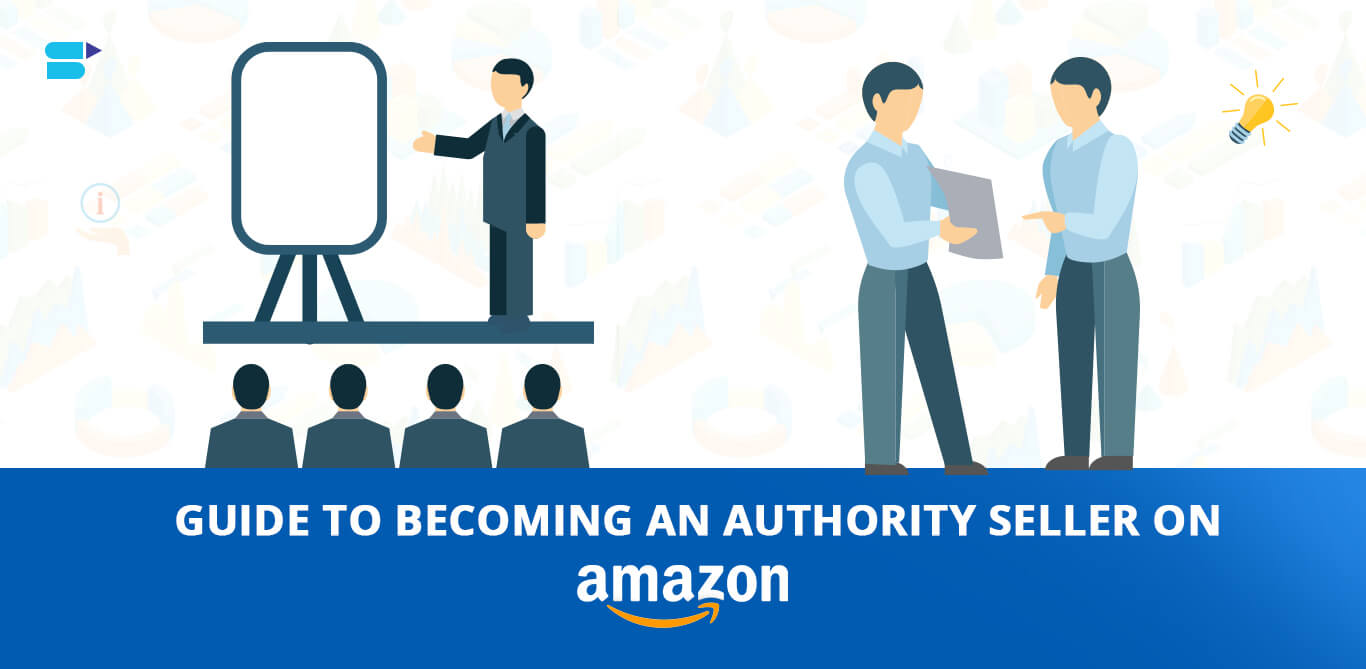
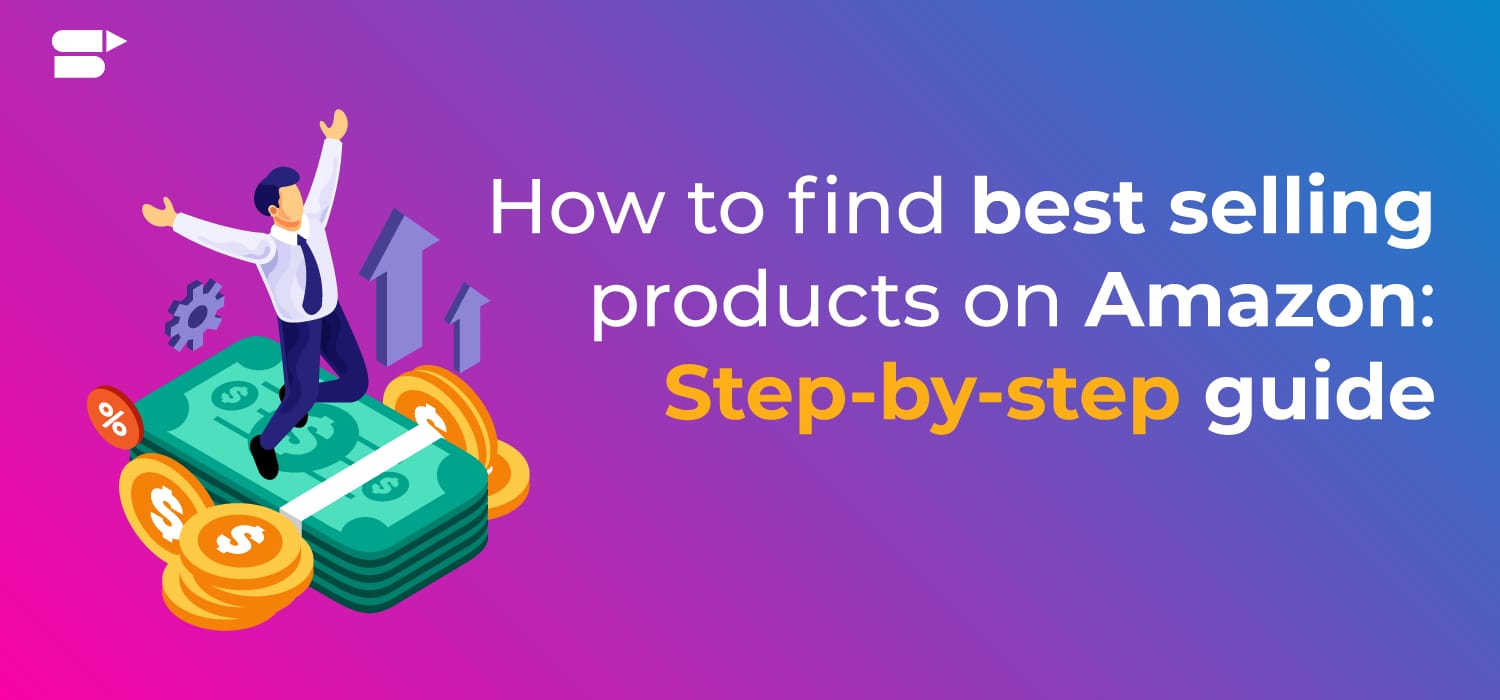
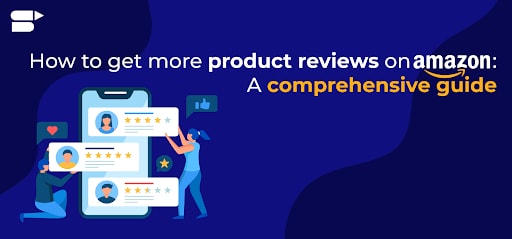
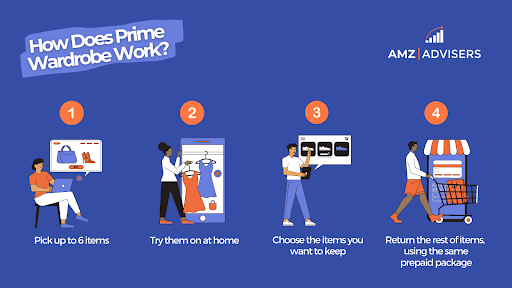
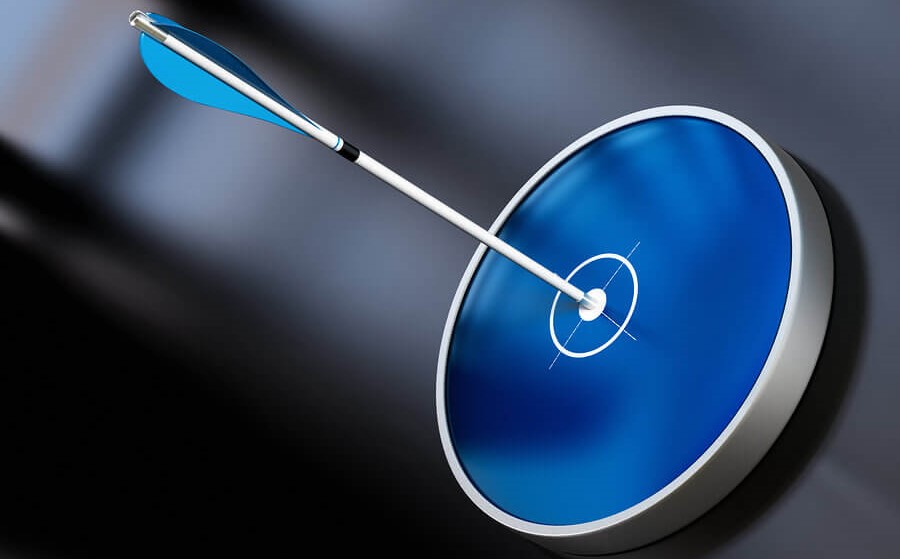



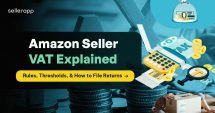
Miles Bradford
November 18, 2025The caution about Amazon’s limited reporting is spot on — combining BTP with external analytics makes the strategy much stronger.
Conrad Walker
November 18, 2025I didn’t realize tailored cross-sell promotions were possible; that adds a nice way to increase AOV.
Talia Greene
November 18, 2025Great insight on the green “Discount” badge, visibility in search and product pages really makes a difference.
Andre Fulton
November 19, 2025The advice to track opt-out rates is smart since it gives sellers clear feedback on customer sentiment.
Vivian Marks
November 20, 2025The reminder about avoiding overlapping promotions is important — too many discounts can hurt margins quickly.
Parker Sutton
November 20, 2025Your step-by-step setup process makes it easy for sellers to start using BTP without confusion.
Paige Lawson
November 20, 2025I like how you connect promotions with customer lifecycle stages; it makes the whole approach much more intentional.
Spencer Reid
November 20, 2025This article explains Brand Tailored Promotions really clearly — segmenting shoppers like cart abandoners and repeat buyers is a smart strategy.
Everett Blake
November 20, 2025The example showing how a small personalised discount can push high-intent shoppers is very practical.
Bryce Chandler
November 20, 2025The note about needing at least 1,000 customers in a segment is very helpful for setting the right expectations.